Shropshire was established during the division of Saxon Mercia into shires in the 10th century. It is first mentioned in 1006. After the Norman Conquest it experienced significant development, following the granting of the principal estates of the county to eminent Normans.
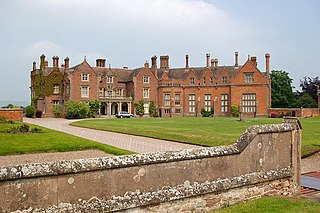
Loton Park is a country house near Alberbury, Shrewsbury in Shropshire, on the upper reaches of the River Severn. It is a Grade II* listed building. It has been the seat of the Leighton family since 1391.

Alberbury with Cardeston is a civil parish in Shropshire, England. According to the 2001 census it had a population of 645, increasing to 1,011 at the 2011 Census. It includes the villages and hamlets of Alberbury, Cardeston, Little Shrawardine, Wollaston, Halfway House, Wattlesborough Heath and Rowton, and has Alberbury Castle and Wattlesborough Castle within its borders. To the west the parish borders Wales, whilst to the north it is bounded by the River Severn.
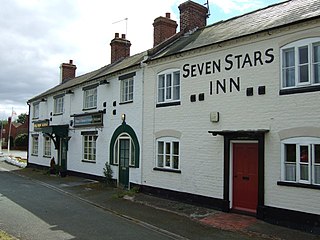
Halfway House is a village in Shropshire, England, halfway between Shrewsbury and Welshpool on the A458 road. Also, it is known to be halfway between Birmingham and Aberystwyth.
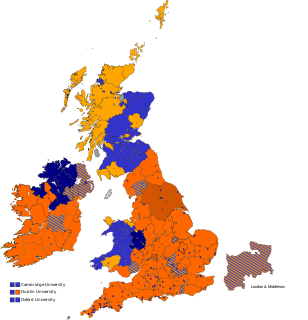
Shropshire was a constituency of the House of Commons of the Parliament of England, then of the Parliament of Great Britain from 1707 to 1800, and of the Parliament of the United Kingdom from 1801 to 1832. It was represented by two Knights of the Shire. It was split into North Shropshire and South Shropshire in 1832.
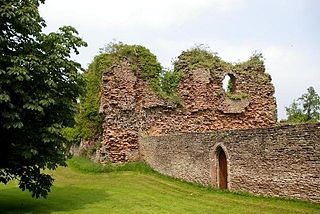
Alberbury Castle is in the village of Alberbury, some nine miles north-west of Shrewsbury, Shropshire and very close to the border with Wales. The building has been constructed from locally available red sandstone. It is a Grade II listed building.

Alberbury is a village in Shropshire, England, 9 miles (14 km) west of Shrewsbury on the B4393 road which travels from Ford to Lake Vyrnwy. It is on to the England-Wales border, marked by Prince's Oak.
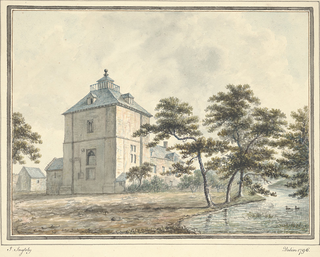
There have been two baronetcies created for persons with the surname Leighton, one in the Baronetage of England and one in the Baronetage of the United Kingdom. One creation is extant as of 2010.
This is a list of sheriffs and high sheriffs of Shropshire

Sir Baldwin Leighton, 7th Baronet was an English landowner and politician, who sat in the House of Commons from 1859 to 1865.

Sir Baldwyn Leighton, 8th Baronet was an English Conservative Party politician who sat in the House of Commons from 1877 to 1885.

Sir Andrew Corbet was a prominent English Protestant politician of the mid-Tudor and early Elizabethan periods: a member of the powerful Council in the Marches of Wales for a quarter of a century. Drawn from the landed gentry of Shropshire and Buckinghamshire, he was twice a member of the Parliament of England for Shropshire.

Richard Corbet was an English landowner and politician who represented Shropshire in the parliaments of 1558 and 1563.

Robert Corbet (1542–1583) was an English landowner, diplomat and politician of the Elizabethan period, a Member (MP) of the Parliament of England for Shropshire, his native county.

George Bromley was an English lawyer, landowner, politician and judge of the Mid-Tudor and Elizabethan period, a member of an important Shropshire legal and landed gentry dynasty. Although his career was overshadowed by that of his brother Thomas Bromley, George Bromley was of considerable importance in the affairs of the Welsh marches and the Inner Temple. He was an MP for Liskeard 1563, Much Wenlock in 1558 and 1559 and Shropshire in 1571 and 1572.
Sir Richard Corbet (c.1545–1606) was an English landowner and politician of the Elizabethan period.

Thomas Leighton was an English soldier and politician.
Francis Bromley was an English politician. A member of an important legal and landowning dynasty of the Shropshire landed gentry, his career was cut short by an early death. He was a Member (MP) of the Parliament of England for Shropshire in 1584.
Alberbury with Cardeston is a civil parish in Shropshire, England. It contains 58 listed buildings that are recorded in the National Heritage List for England. Of these, one is listed at Grade I, the highest of the three grades, seven are at Grade II*, the middle grade, and the others are at Grade II, the lowest grade. The parish contains the villages and settlements of Alberbury, Cardeston, Wollaston, Halfway House, and Rowton, and is otherwise rural. In the parish the listed buildings include two ruined castles, two country houses and associated structures including lodges, and three churches and items in the churchyards. Most of the other listed buildings are houses, cottages, farmhouses and farm buildings, and the rest include the remains of a windmill, two milestones, a public house, and a war memorial. Three of the listed buildings are also Scheduled Monuments.
Sir Edward Leighton, 1st Baronet (c.1650–1711), of Wattlesborough Castle, Shropshire, was a Whig politician who sat in the English and British House of Commons between 1698 and 1710.

















